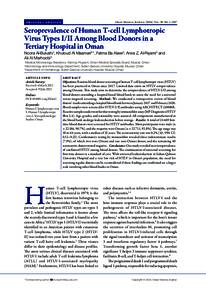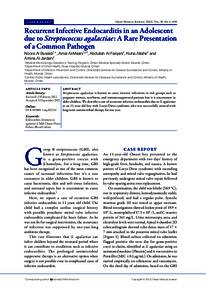وثيقة
Seroprevalence of human T-cell lymphotropic virus types I/II among blood donors in a tertiary hospital in Oman.
المعرف
DOI 10.5001/omj.2024.42
المصدر
Oman Medical Journal, v. 39, no. 1, e587 p. [1-5].
المساهمون
Al-Maamariyah, Khuloud., مؤلف
Ba Alawi, Fatma., مؤلف
Al-Riyamiyah, Arwa Z., مؤلف
Al-Marhoobi, Ali., مؤلف
الدولة
Oman
مكان النشر
Muscat
الناشر
Oman Medical Specialty Board.
ميلادي
2024-01-01
اللغة
الأنجليزية
الملخص الإنجليزي
Routine blood donor screening of human T-cell lymphotropic virus (HTLV)
has been practiced in Oman since 2017. Limited data exists on HTLV seroprevalence
among Omanis. This study aims to determine the seroprevalence of HTLV-I/II among
blood donors attending a hospital-based blood bank to assess the need for a universal
versus targeted screening. Methods: We conducted a retrospective review of blood
donors’ results attending a hospital blood bank between January 2017 and February 2020.
Blood samples were screened for HTLV-I/II antibodies using ARCHITECT i2000SR.
Reactive samples underwent further testing by immunoblot assay (MP Diagnostics HTLV
Blot 2.4). Age, gender, and nationality were assessed. All components manufactured at
the blood bank undergo leukoreduction before storage. Results: A total of 24 469 firsttime blood donors were screened for HTLV antibodies. Most participants were male (n
= 22 186, 90.7%), and the majority were Omani (n = 22 711, 92.8%). The age range was
18 to 64 years, with a median of 32 years. The seroreactivity rate was 0.2% (43; 95% CI:
0.12–0.23). Confirmatory testing by immunoblot revealed three indeterminate results
(7.9%), of which two were Omani and one non-Omani donor, and the remaining 40
seroreactive donors tested negative. Conclusions: Our study revealed zero seroprevalence
of confirmed HTLV among blood donors. The continuation of universal screening for
first-time donors is a standard of care. With universal leukoreduction at Sultan Qaboos
University Hospital and a very low risk of HTLV in Oman’s population, the need for
screening regular donors can be reconsidered if these findings are confirmed on a larger
scale involving other blood banks in Oman.
ISSN
1999-768X (Print)
2070-5204 (Electronic)
قالب العنصر
مقالات الدوريات


